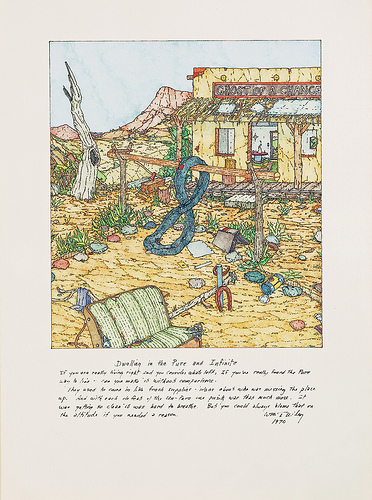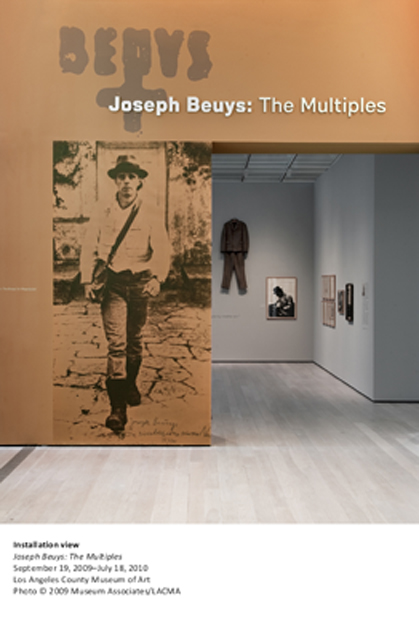Summer is the perfect time to visit any museum anywhere, and museums know it, putting on some of their best shows of the year. But in California this season the museums offerings are notably magnificent, not to mention manifold. As summer shows are wont to do, many if not most of these last until the equinox or thereabouts, but several are ending no later than this weekend. Here's your heads-up.

WILLIAM T. WILEY, Dwelling in the Pure and Infinite, 1970, watercolor and ink on paper, 30 x 22 inches, copyright William T. Wiley, Collection of Betty and Jack Schafer, Photograph by Donald Felton, Almac Camera, San Francisco
That most American of inner cosmographers, William T. Wiley, gets his due in a retrospective aptly entitled "What's It All Mean," currently at Berkeley's University Art Museum (and previously at the Smithsonian in D.C.). No question mark follows, turning the title into a rhetorical shrug - one that masks, or perhaps underscores, an urgent search for a sense to the world and the cosmos. The narratives Wiley pursues, thickly and manically, throughout his oeuvre seem to agitate around worldly matters, and respond as often as not to headlines and sociopolitical causes celebres - ecological issues, capital punishment cases, wars - or to the minutiae of Wiley's own life. Actually, make that "and to the minutiae;" since leaving behind the weird but minimalistic imagery of his early Funk period, Wiley has crammed his paintings, drawings, sculptures, and assemblages with as many things and references and references to things and things turning into references as he can, challenging his viewers to pull apart his labyrinthine renditions even visually, much less iconographically. It can hurt to look at the wrong Wiley the wrong way; you have to relax and fall into the picture, or get on your knees and practically pick through the object (which on occasion sprawls into near-installation), and you can bet that the museum guards aren't gonna let you get close enough.
In this very over-ripeness lies the transcendence of Wiley's vision. We thought we had those strange funk images pegged as a kind of backwoods pothead surrealism, and that readiness to let anything metamorphose into a hapless mutant giant version of itself does power Wiley's aesthetic (and ethos) throughout. But it's in the comic-strip-on-acid-and-steroids approach to which Wiley has adhered over the last four decades that we witness his metamorphic process churn and accrue, revealing not just a mind, but a universe, in feverish overdrive. What keeps his fecund free association from collapsing into Boschian damnation, especially given the mordant, anxiety-provoking realities Wiley constantly harps upon, is his sense of the absurd and the self-deprecating wit and general good humor that results. It's obvious that, however dense and vacuum-abhorrent, every work of Wiley's is a work in progress, not so much finished as put aside - and, with its writing and sketching and myriad wandering lines, that his art is one of notation, aside, and doodle, an active meditation that embraces the artist's, and our own, deficit attention span.
The retrospective is either way too much to take in or not enough to answer your questions about Wiley's mind (and hand) - or, most likely both. Wiley's art can be as addictive as potato chips and as irresistible a guilty pleasure as (and because of) the puns that course through his unlikely apparitions. And, like those temptations, a little goes a long way and a lot makes you kinda queasy. But the crisps and the wordplays are organic. Don't let Wiley's alter ego fool you; Mr. Unatural [sic] is as natural as they come.

So was Wiley's fellow art-shaman, Joseph Beuys. As German in his fervent bombast, follow-me exuberance, and intellectual navel-gazing as Wiley is American in his own, Beuys is famous - okay, infamous - for his self-mythologizing symbology. But any good Beuys show reveals that, at least once he got over himself and set about changing humanity, he maintained this symbology as a means to an end - and the end wasn't world domination but world harmony. If Wiley thinks about political issues, Beuys - who was instrumental in creating Germany's powerful Green Party - tackled them head on, with a mixture of heady political idealism and social and artistic savvy. "Joseph Beuys: The Multiples" effectively lays bare his causes, his strategies, his sources, and his attitudes.
It had better. "Beuys: The Multiples" contains almost 600 objects - nearly all the prints, limited-edition objects, and ephemera (posters, postcards, etc.) the artist produced between the early 1960s and his death in 1986. Displayed in LACMA's Broad Contemporary Art Museum, they are all - all - borrowed from the Broad Art Foundation, and displayed in LACMA's Broad Contemporary Art Museum. (Yes, it would indeed be cool were Eli and Edythe Broad to re-install the lot of them in their a-borning museum in downtown LA.) As mentioned, these objects range fabulously in size, material, and impact, some as small as sugar cubes, some as large as blankets. You've got wooden boxes, rusty implements, mounds of fat, maps, pamphlets, envelopes, videos, LPs, newspapers, and a vast range of other stuff, all either manufactured or altered by Beuys to embody his thought process and trace the energy of transformation - via, you got it, the transformation of energy by thought. Graphically powerful though they tend to be, Beuys' multiples are conceptual art at its best, at once tools for expanding minds and by-products of his efforts at this expansion.
Beuys' art is doubly hermetic, couched not only in his personal language(s), but also in the conditions of postwar Europe (in particular, of course, Germany). "Joseph Beuys: The Multiples" helps decode this sea of enigmas at least somewhat by organizing the objects in under eight distinct rubrics. "Myth" traces his auto-mythmaking and his references to the cosmologies of European, and Asian, civilizations. "Fluxus and Performance" marks Beuys' brief but profitable association with the international proto-conceptual movement, whose own emphasis on the cheap, eminently reproducible artwork inspired him to this cascade of tchatchkes (and the live-action artwork that generated many of them). "Environmentalism" and "Teaching and the F.I.U." look at Beuys' on-the-ground proselytizing for a new, post-socialist kind of polity, both with regard to the land and to pedagogy (the "F.I.U." was the Waldorf-School-for-young-adults "Free International University" Beuys founded in the early 1970s). "Beuys and America" traces the anti-capitalist's conversion from America-hater to America-lover. "The Readymade" relates Beuys' approach to object-making - and appropriating - to the ur-conceptual (and ur-Fluxus) Dadaism of Marcel Duchamp, while "Publicity" shows him making a name for himself through his activity and making a name for his causes through himself. Finally, "Political Activism and the Holocaust" gets to the heart of Beuys' angst, showing him grappling with memory and culpability on a personal and a national level.
While you're down in Los Angeles, pop by the Municipal Art Gallery in east Hollywood's Barnsdall Park for the COLA 2010 Individual Artists' Grants exhibition. Displaying the work of ten visual artists (two performers and a writer were also given funds), the show not only argues for the deep vein of distinctive, almost defiantly creative energy that (still) runs through the city's art community, but for that vein's increasing complexity and depth. There is insufficient room here to describe the work on view, or even single out favorites. (Full disclosure: as one of the catalogue essayists, I have a stake, however negligible, in one of the artists.) Suffice it to say that each artist is provided the equivalent of her or his own gallery, and nobody blows the opportunity. In this regard, especially, I hope what I've been hearing about the fate of the COLA grants in the face of LA's financial crisis isn't true. Indeed, I hope what I've been hearing about the Municipal Gallery's own fate turn out to be either false alarmism or (more likely) early-warning canary squawking that saves one of LA's oldest and most beloved cultural institutions.
All shows end on Sunday, July 18.